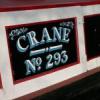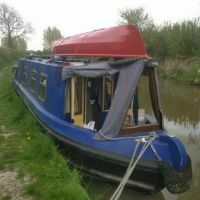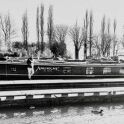

springy
Member-
Posts
806 -
Joined
-
Last visited
Profile Information
-
Gender
Male
-
Location
West Midlands
Recent Profile Visitors
9,297 profile views
springy's Achievements
Proficient (7/12)
86
Reputation
-
AIUI all Clayton's tank boats were wooden, they did briefly own at least one second hand iron composite (Adder ex FMC IIRC) but disposed of it fairly quickly. For the tar traffic the wooden hull was important as it acted as an insulator keeping the heat in and the tar more liquid. springy
-
Found the Shell depot photo - also on the "Made in Oldbury" site, undated but 5 horse boats springy
-
Found these photos in the Thomas William King collection on the "Made in Oldbury" site showing the last two loads of oil carried by claytons boats and dated to 1956. Somewhere I have also seen a photo of the Shell depot at langley green with a Claytons boat being unloaded, and 3 or 4 others waiting, but I'm unable to find it at the moment. For clarification the oil was put straight into the hold in bulk, no other tanks or containers were involved, with (IIRC) a motor carrying some 15-18 Tons and a horse boat 20 - 22 tons depending on whether it was fuel oil or lubricating oil. And some single Horse boats continued to be used as well as motor/butty pairs. Cowburn and Cowpar had at least one boat with round tanks lowered into the hold but they carried "chemicals" including carbon disulphide. springy
-
springy started following Those sunken dayboats along the Walsall Canal... , Tanker Narrowboats. , Hand/Stirrup Pump for Emptying Built In Water Tank and 5 others
-
From 1924 to 1955 Thomas Clayton carried both Lubricating Oil and Fuel Oil (diesel) from the Stanlow refinery on the Manchester Ship canal to the Shell Depot on the Titford Canal (just past Langley Maltings), using the same "Tank" boats as used for the tar traffic. These were simply wooden hulled narrowboats with a "tight" bulkhead in front of the cabin/engine and another at the fore end of the hold. Motors had another bulkhead roughly in the centre of the hold, and this had small "paddle" in it to allow controlled filling of the rear half, I don't know if the horse boats had similar arrangement. Double planked deck with sliding hatch covers over a hinged lid (which would have a lead seal attached after loading to prevent pilfering). From '24 to '39 all the boats were horse drawn with the then "new" motors being used paired with a horse boat from then on. The contract finished in '55 due to a pipeline direct to the midlands becoming "available". In 1949 TC(O) ltd. carried just shy of 30,000 tons on the Shell contract. I have often wondered why horse boats lasted so long, but given the "one way" nature of the traffic it may have been at least in part due to the better handling of an empty horse boat compared with an empty motor. Info (mostly) from Alan Faulkners "Clayton's of Oldbury" and conversations with various ex Clayton's boatmen. springy
-

Hand/Stirrup Pump for Emptying Built In Water Tank
springy replied to Bosley Dave's topic in Boat Equipment
How big is the tank - you are unlikely to find any sort of hand pump which will deliver much more than a couple of litres/stroke - even a relatively small tank is going to require an extended period of hand operation to empty by hand. A wetvac may be a good idea as it will be useable for other things but will need emptying every 20 litres or so, any electric pump will need to have a decent duty cycle as you will probably need to run it for quite a long period - maybe an hour at a time even for a moderate sized tank. springy -

Expanding a tube, to fit onto a 25mm male thread. For an ariel mount.
springy replied to Tigerr's topic in Boat Equipment
A quick google for "tube expander" found lots of things like the following, intended for use on copper air con systems, and copper is probably more ductile than your aluminium tube but may do the job https://www.amazon.co.uk/Repairing-Conditioner-Copper-Expander-Swaging/dp/B09SDZ54WX/ref=asc_df_B09SDZ54WX/?tag=googshopuk-21&linkCode=df0&hvadid=641545482634&hvpos=&hvnetw=g&hvrand=12892406534298187719&hvpone=&hvptwo=&hvqmt=&hvdev=c&hvdvcmdl=&hvlocint=&hvlocphy=1007147&hvtargid=pla-1729943784233&psc=1&mcid=38dfb78338a53b8ba27c78619c612445 springy -
This post cannot be displayed because it is in a forum which requires at least 10 posts to view.
-
I know them as a "Bottle Stove" commonly used in BCN day boat cabins - Birchills at BCLM has one. springy
-
I saw your Pic and thought "I've got one of those somewhere", however whilst the mug has a pretty identical shape, the design on the side is different - whilst the bottom still says "Titford Two" the upper text reads "National Waterways Rally" , there is the IWA logo centrally with 1982 below it and what could be a small version of the bird standing on an half moon with the BCN on it above, because of the reduced size the detail has been lost. springy
-
Re Sally - I don't think there's anything left there, the scrapyard was cleared some years ago and a care home now occupies the site, its possible that Sally was removed at that time. springy
-
Offside adjacent to Tipton Road Bridge on the Dudley tunnel branch, IIRC somewhere I have a similar photo of Sally in slightly better condition - sunk but cabin side intact. springy
-
IIRC the BSS specifies the size according to the size and quantity of bottles to be stored in the locker, and remember its a "Drain" (gas is heavier than air) and if you drill as close to the bottom plate of the locker as you can, you may also need to use a file or die grinder to widen the bottom to create a half moon shape and get the bottom of the drain hole flush (as far as possible) with the bottom of the locker. springy (beaten to it by MtB)
-
Some years ago I acquired something I find ideal for my straight chimney - 3 section aluminium handle, well made sporting a broad arrow, and a short bristle head approx 3" diameter boss with 1" bristles. Easy to store and the rigid handle allows me to give the chimney a good scrub. I was told its original purpose was for cleaning gun barrels. springy
-

Those sunken dayboats along the Walsall Canal...
springy replied to davidwheeler's topic in History & Heritage
I can't remember when, but there were (and I think still are, though only visible in winter when there is less vegetation) several sunken day boats on the offside in the stretch between Birchills Junction and Pratts Bridge - the location IIRC of Ken Keay's yard. No idea which ones. springy -
The middle 6 have a layout quite similar to factory 3, the sideways extended short pounds between each lock chamber provided extra water storage so that drawing a lock full of water off the pound did not lower the pound level too much. Retention of the wharf and part of the original line below top lock would serve the same purpose for that pound, it is possible that the "arm" alongside the bottom lock served a similar purpose for that pound as well as potential use as a wharf. The end of that "arm" is also the location of the bywash for the bottom lock. springy







